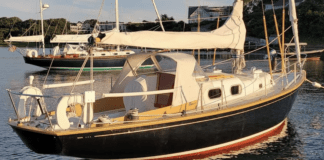
The state of Florida is at it again. The Florida Fish and Wildlife Commission held a couple of poorly advertised workshops earlier this month to discuss the future of anchoring in the state. The public hearings made it clear that the state is once again trying to tighten anchoring restrictions in coastal areas, particularly in urban areas along the Intracoastal Waterway.
Currently, six municipalities in Florida are participating in a pilot mooring field program to help guide future legislation. Although each of the pilot programs vary slightly, all of the local ordinances restrict anchoring in local waters and instead offer moorings for a fee.
Funded by by state and local taxpayers, the pilot programs were set to expire in 2014 but have been extended to 2017. By then, it is expected that the legislature will try to come up with a unified statewide plan. Cruising groups like the Seven Seas Cruising Association are hoping that the state carries out a thoughtful, data-based assessment, and whatever solutions it proposes (if any) are applied statewide, and do not restrict cruising sailors’ rights to navigate.
Several municipalities, however, are looking to accelerate the assessment process and regain control of anchoring in their local harbors. A bill that failed in the state legislature earlier this year had proposed allowing 64 other communities to enact their own anchoring restrictions. The bill drew sharp criticism from cruisers, who feared a return to the pre-2009 days when a confusing mish-mash of local ordinances regulated anchoring in the state.
Based on Jim Flannerys news story on the recent workshops, it appears that property owners in Fort Lauderdale and Miami Beach are behind the latest push. In an anchoring concepts for consideration handout distributed at the hearing, one provision suggested restricting anchoring from within 300 feet of a residential property. Critics say the decision would effectively eliminate all anchorages in Miami Beach and Fort Lauderdale.

Overall, the pilot mooring programs, including one in Practical Sailors home city of Sarasota, are yielding mixed results. In Sarasota, the first set of moorings failed to meet the required load test, delaying the project’s implementation. At one of the recent workshops, a boater reported her mooring in St. Augustine failed in calm weather, causing $30,000 damage to her boat. In other areas, particularly Boot Key Harbor in Marathon, boaters seem general satisfied with the pilot program.
By looking at the post-implementation survey data (see table), the only goal that every pilot program clearly achieved was a reduction in the number of derelict boats. As one might expect, all conspicuously failed to improve access to local waters-a problem that is being compounded as new developments gobble up marinas and working boatyards. In some cases, creating the mooring fields exacerbated several of the problems they were intended to solve.
In Sarasota, the local boats that were shooed out of the anchorage to make room for moorings simply moved slightly south, just outside the mooring field boundary to a more sensitive seagrass area. Though many predicted this would happen, the local project director expressed surprise in his summary report to the Fish and Wildlife Commission (FWC).
Unfortunately the remaining vessels that moved have more or less moved south of the City mooring field establishing a new, unregulated anchoring area. This area is healthy with sea grass beds based on aerial review, shallow during low tides and near two inland channels. Vessels have been observed listing at low tide in this new area. Vessels owners have additionally established a new dingy (sic) area near a public right of way that leads to a sidewalk.
Anyone who takes the time to skim over Appendices D, E, and F (starting on page 117) of the FWC Final Recommendations to the legislature will note how several of the municipalities (Sarasota and St. Petersburg being the chief offenders) seem to present a far rosier picture of the pilot progams than the data actually supports. As far as I can tell, the real winner in Sarasota’s local mooring field scheme is Jack Graham Inc. The commercial enterprise manages the mooring field and leases the prime waterfront real estate from the city for the rate of three percent of its earnings-an arrangement critics have for years blasted as a sweetheart deal. In a recent settlement with the county, the company was excused from paying more than $1 million in local taxes.
In my view, Florida is continuing down the same path it has followed for years, wasting time and resources trying to solve a “problem” that is largely one of perception. The most frequently cited complaints, such as abandoned or derelict boats, can be more cheaply addressed by enforcing existing laws. Judging from the hasty way in which the latest round of workshops were carried out, it is obvious that boaters who care about protecting their rights to navigate and anchor freely in the state will have to remain vigilant.
Some things never change.








































